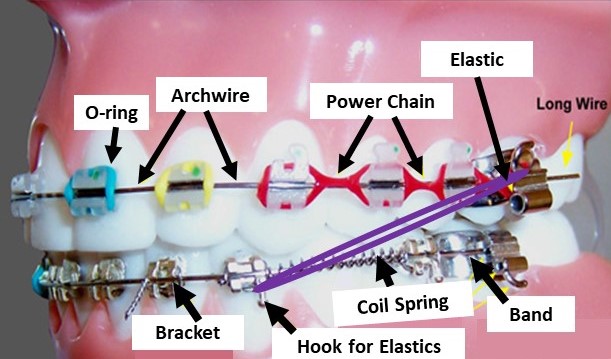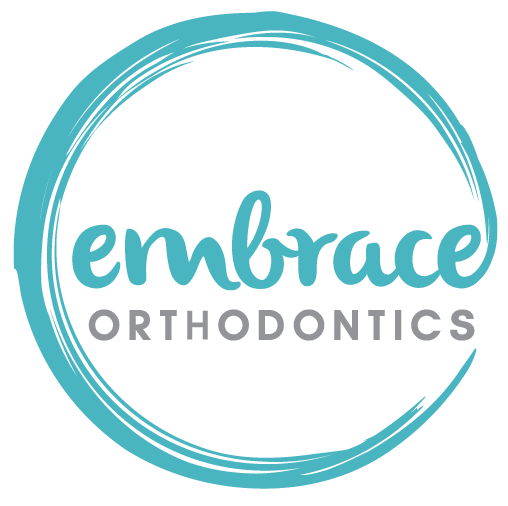
Understanding the Different Parts of Braces
Do you have or are you getting braces, and need help understanding the different parts of braces? Embrace Orthodontics provides braces and other orthodontic solutions to many families in the Ann Arbor area of Michigan. As a highly experienced orthodontist’s practice, we can shed some light on exactly how braces work and what you can do to keep them working at their best.
Braces 101
Parts of Braces
Braces are intricate treatment options made up of many interlocking parts. Patients of all ages benefit from learning more about the different parts of braces.

Brackets:
These parts are the small “squares” attached to the front and side teeth. They adhere to the enamel surface of the teeth with the use of special glue. While traditionally they are made of metal, some brackets are clear, made of ceramic material, allowing them to match closely the color of the teeth thereby making them less visible in the mouth.
Bands:
These are the metal rings that fit around the back molar teeth. They are affixed to the teeth with the use of special cement. Since bands are bulkier than brackets, they are not routinely used in our office unless brackets have trouble staying on the back molars.
Power Chain:
Power chain, also known as the energy chain, is made of the same material as the o-rings and it’s a sequence of rubber rings connected to each other like a chain. The power chain stretches over a number of brackets. It can pull teeth closer together, move teeth along the archwire, and close spaces.
O-rings:
O-rings are made of rubber and affix to brackets. By wrapping the o-rings around the “wings” of brackets, each o-ring holds the archwire to their specific bracket. O-rings do lose their elasticity and strength over time, thus they need to be regularly replaced every 6-8 weeks during your orthodontic adjustment visit.
Archwire:
Archwire is the wire connecting all brackets and/or bands. With o-rings or power chain securing the archwire into the brackets/bands, it pulls brackets/teeth while assuming its original smooth arch form, thereby aligning the teeth.
Coil Springs:
When space needs to be created, coil springs are added onto the archwire to span between brackets. The springs will push apart the brackets thereby creating more space.
Elastics:
Often known as “rubber bands”, elastics are used to correct the bite relationship of patients' top and bottom teeth by connecting bracket(s) in the upper arch to bracket(s) in the lower arch. Elastics often need to be replaced several times daily.
What Are The 4 Types of Braces
There are four broad categories of braces in common usage today.
Metal Braces:
traditional metal braces are composed of stainless steel brackets and wires applied to the front of the teeth. They are distinctive in appearance and highly visible. They also require adjustment by an orthodontist every 4-8 weeks.
Lingual Braces:
similar in composition to metal braces, the main difference between the preceding varieties and lingual braces is location. Lingual braces are fitted to the rear of the teeth, and are therefore more inconspicuous than other braces. However, they do take longer to correct alignment issues, and can be fussier than normal braces because of being tucked away less visibly.
Clear/Ceramic Braces:
mechanically identical to metal braces, these use tooth- or enamel-colored ceramic parts to blend in more than stainless steel. As with metal braces, regular adjustments are required for them to serve their purpose.
Self-ligating Braces:
unlike the traditional metal/clear braces which require o-rings or power chain to engage the archwires with the brackets, self-ligating braces come with a built-in “door” on each bracket, thereby eliminating the o-rings to engage the wires with the bracket. The most famous self-ligating braces are called Damon braces. In the case of closing space(s) in between teeth, a power chain will still be needed to connect the self-ligating brackets.
What Are All the Stages of Braces?
There are three general phases to how braces treatment time operates, and these phases typically take at least 20 months to complete altogether. The first phase is planning.

- Planning. There can be no orthodontic treatment for misaligned teeth without a careful planning stage. Embrace Orthodontics values a comprehensive treatment plan. In order to devise the best plan possible for each patient’s needs and budget, we conduct a thorough consultation that includes photos and X-rays which helps Dr. Li diagnose the patient’s orthodontic problems and needs. Whenever indicated, we also use our state-of-the-art iTero Element scanner to get a thorough digital impression of each tooth in your mouth. This process can take as little as 10 minutes to perform and provides an extremely accurate 3D view of your mouth. Our doctor can then use the scan to perform a simulation to visualize the treatment outcome which can be very helpful in planning difficult orthodontic cases.
- Active Treatment. In the active stage, braces or aligners will exert steady, gentle pressure on teeth to allow teeth to be gradually moved in a controlled manner into their desired place and the bite aligned. Once teeth are moved, bones around the teeth will follow the suit and gradually remodel to allow the bone to adapt to the new teeth position. During the active treatment, there are multiple substages. The first substage is called aligning and leveling, when teeth are straightened and coaxed into a uniform height. In the correcting bite substage, any remaining spaces are closed, upper and lower teeth are aligned to fit together correctly, and the bite is changed. In the finishing substage, an orthodontist will review the changes that your mouth has undergone, and whether things are ready for the final stage: retention.
- Retention. It is critically important for a retainer to be worn after braces have rearranged the position of teeth. Many orthodontists will assign a retainer to be worn by a patient, to ensure that the teeth do not return to their old positions. Right after braces/aligner removal, teeth have the highest tendency to relapse, during which time we recommend our patients to wear their retainers all the time. Over time, the bone and soft tissue remodeling have occurred already making aligned teeth position more stable. During this time, retainer wearing time can be reduced to night time only.
If you are curious about how to manage your oral hygiene with braces, such as how to keep brushing and flossing while wearing your braces, our team has some tips for life with braces. For more general advice on orthodontic care, or to make arrangements for a free consultation, please contact us.
